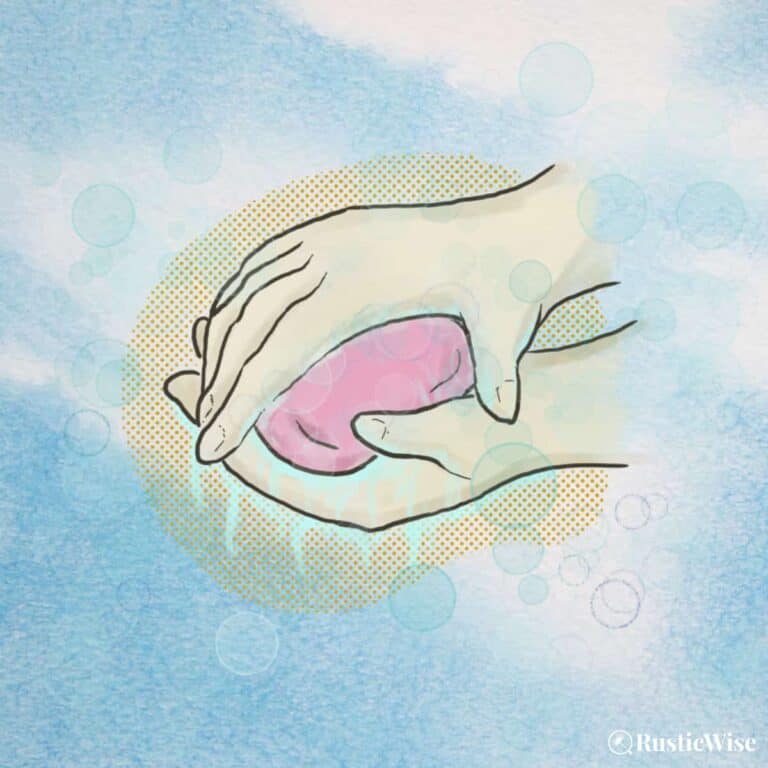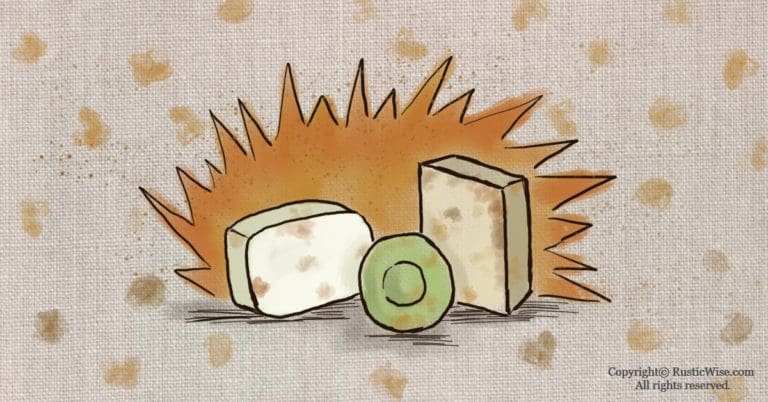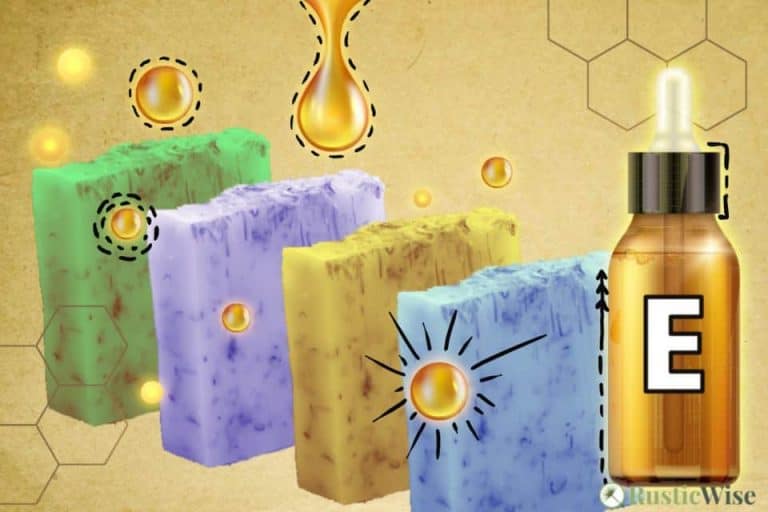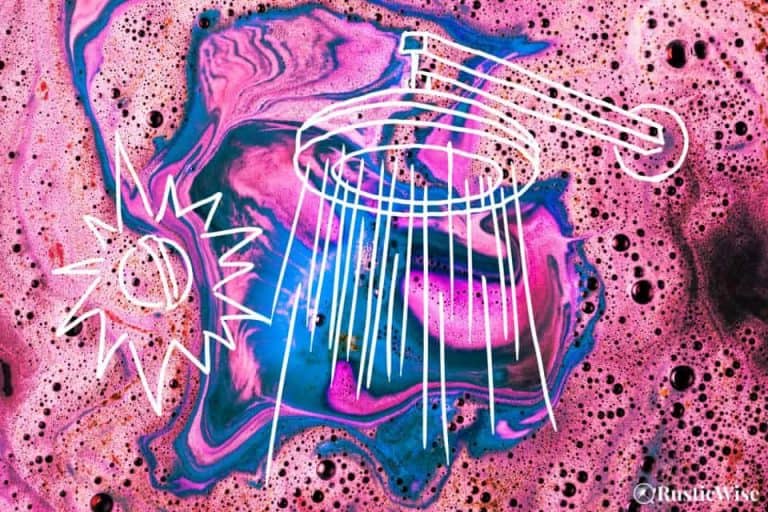Does Turmeric Soap Lighten Skin? The Answer May Surprise You
Turmeric, the same golden powder used for spicing up curries, is also a mainstay in Ayurvedic treatments both as a tonic and as a beauty treatment. The purported skin benefits of this natural ingredient include skin lightening and brightening, fading dark spots, soothing acne, and acting as an anti-aging component.
If you’ve heard others champion the beauty benefits of turmeric, you may wonder, does turmeric soap lighten skin, really? Many studies support the skin lightening properties of curcumin, a polyphenol derived from turmeric. There’s also evidence to support its anti-inflammatory and antimicrobial properties. Plus, it’s a rich source of antioxidants.
It’s probably wise to meet any beauty claims with a healthy dose of skepticism. (After all, if you’ve ever experimented with painful skincare trends such as peel-off masks, you may think twice before going gung-ho on other trends.) Luckily, turmeric appears to deliver benefits to the skin. But there are also drawbacks.
Let’s take a deep dive into the many uses of turmeric powder.
A closer look at turmeric
Turmeric (Curcuma longa) is a perennial plant found growing in India and Indonesia. It belongs to the same family as ginger.¹ Sometimes it’s called curcumin, Curcuma, and occasionally, it’s called “Indian saffron.”
(Note: Turmeric is only called Indian saffron because of its similar bright yellow coloring. The two spices taste quite different!)
The rhizomes (underground roots) are the coveted part of the plant. In particular, the finely ground rhizomes are what we use for a wide range of applications.
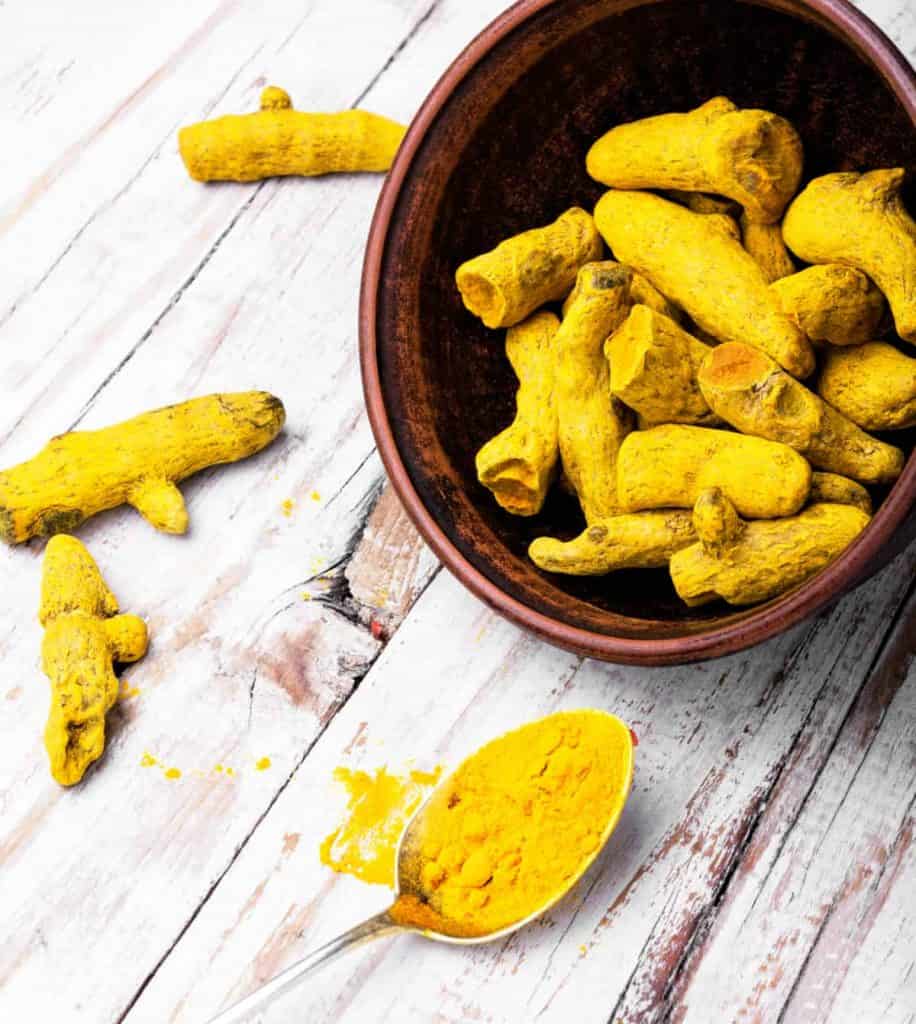
Credit: Vector State
Here are a few uses of turmeric, past and present:
- Beauty and skincare: A mainstay in Ayurvedic treatments as a beauty treatment. In some Asian countries such as India, turmeric water is prepared as a facial toner or face mask for glowing skin. Turmeric, or its derivative curcumin, is a common ingredient in soap bars, lotions, and other beauty products. It’s believed to help with a variety of skin issues including acne, hyperpigmentation, eczema, and signs of aging such as fine lines and wrinkles.
- Culinary spice: With its bright yellow-orange color, peppery fragrance, and warm, earthy flavor, this versatile spice is used in curries, pickling recipes, and other savory dishes.
- Perfume: The sharp peppery notes were once used as a perfume in ancient times.¹
- Medicinal purposes: When ingested as a tea or in pills, its anti-inflammatory properties aid in digestive issues and arthritis.¹
Properties of turmeric
When applied topically to skin, or ingested, this golden powder has many beneficial properties.
- Anti-inflammatory: Skin inflammation can occur for a number of reasons—allergic reaction to products, sunburn, or a chronic inflammatory skin condition, such as eczema. Curcuma longa contains soothing properties to combat redness and swelling in the skin.
- Antimicrobial: The yellow roots contain antimicrobial properties which fight against a broad spectrum of harmful bacteria, fungi, mold, and other pathogens. This helps preserve the health of the epidermis.
- Rich source of antioxidants: The antioxidant properties help to fight free radicals which can cause skin inflammation by damaging skin cells.
Purported benefits of turmeric soap for skin
As a natural skin ingredient, Curcuma longa has a lot going for it. Here’s a quick look at what others are saying about turmeric soap and how it can help your skin:
- Brighten and lighten skin: This yellow root is not only said to lighten the color of skin, but can also lend a golden color to brighten skin. (Perhaps not too surprising, as cooking with turmeric can also stain your hands yellow!)
- Fade dark spots or hyperpigmentation: Use turmeric soap to minimize skin discoloration from age spots. It’s also said to lighten scars and reduce dark circles under the eyes.
- Help with acne: The antibacterial and anti-inflammatory properties help keep acne in check while minimizing redness.
- Soothe skin inflammation: Skin inflammation can manifest itself in myriad ways, including itchy, dry skin, swelling, warmth, or bumpy skin. Curcumin helps minimize these symptoms.
- Promotes more youthful skin: Turmeric has purported anti-aging properties that may boost collagen production and reduce the appearance of fine lines and wrinkles. A study conducted on Caucasian women examined the effects of a turmeric extract cream combined with niacinamide vs. a cream containing niacinamide only. This split-face study showed that the cream containing turmeric was drastically better at combating signs of aging such as wrinkles and fine lines.²
Does turmeric soap lighten or brighten skin, really?
Turmeric soap is a natural product that has been used for a long time in India and Southeast Asia and is gaining popularity in the west. In the past few years, turmeric soap has become increasingly popular. You may have noticed this product for sale at your local health food store. But does it really work as a skin lightener?
Some studies support the claim that this beauty bar can indeed lighten skin.
Scientists have found that curcumin, polyphenol found in turmeric may have skin lightening properties.
A 2018 review of the effectiveness of natural ingredients and their effectiveness on hyperpigmentation found that a topical application of a turmeric extract cream reduced the appearance of facial hyperpigmentation by roughly 14 percent after 4 weeks.² The study was a “split-face study among Chinese women.”
Another 2021 study supports the therapeutic use of, “curcumin and chemically modified curcumin (CMC) for suppressing melanogenesis and tyrosinase activity…”³ The study concluded that modified curcumin is a safe and natural skin whitening agent.
(Note that melanogenesis is the production of melanin pigments, commonly produced by cells called melanocytes. Hyperpigmentation occurs from excessive production of melanin. Tyrosinase is an essential part of melanogenesis.)
By suppressing the production of melanin and tyrosinase, subjects will notice a more even and lighter skin tone. (The more melanin your skin cells produce, the darker your complexion, and vice versa.)
While these studies (and many others) support the use of turmeric as a skin lightener, more human studies are needed in this area.
The takeaway: Curcumin works by curbing melanin and tyrosinase in the epidermis, which may help correct hyperpigmentation and provide some skin lightening properties.
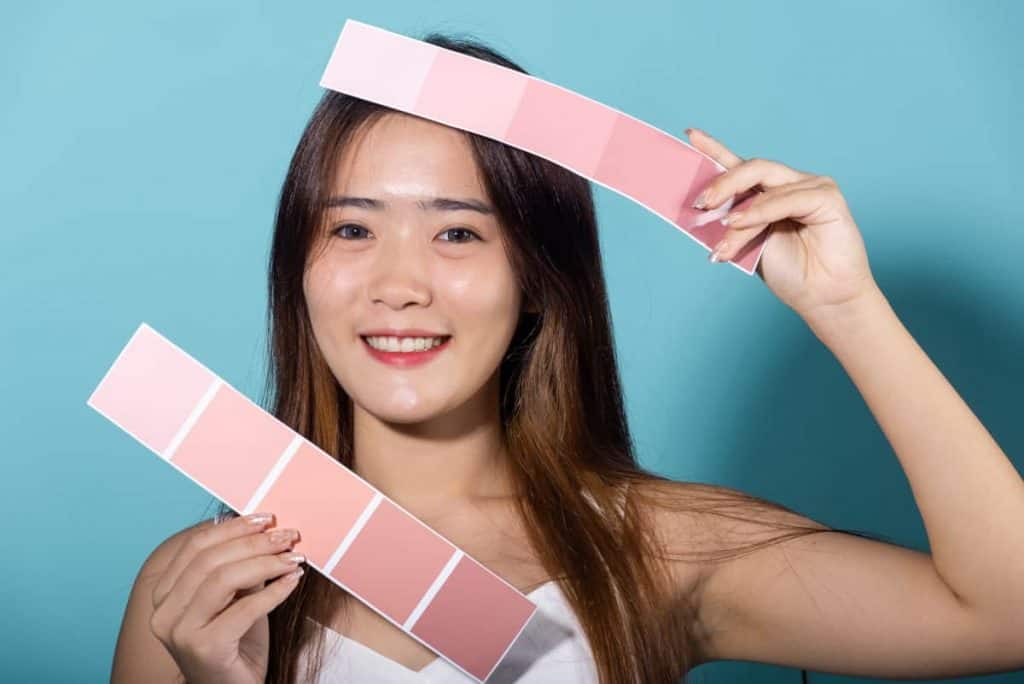
Notes of caution when using turmeric soap on skin
While turmeric powder may have some skin lightening and brightening properties, take these benefits with a grain of salt. Many glowing reviews are anecdotal.
Keep in mind that a product like bar soap is applied topically and quickly rinsed off.
If you experience any noticeable skin lightening benefits, note that it’s a temporary fix at best. It will only last until you shed your outermost skin layer.
According to the Cleveland Clinic, the epidermis (top layer of skin) is continually making new skin cells. You have a new layer of skin every 30 days.⁴
It’s also a treatment that needs continual and consistent use. Once you stop using the soap bar or skin treatment, your original skin tone reappears.
And not all soap bars are created equal. Soap bars and lotions may contain varying amounts of turmeric. Some may contain very little (perhaps not enough to make a difference).
Last, but not least, it appears that you’ll have more visible results if you have a darker skin tone. Those with fair or pale skin may have less prominent skin lightening results.
Is turmeric bar soap good for face and body?
Yes, this natural ingredient is suitable for use on face and body. Look no further than this yellow powder if you’re looking to make an antibacterial bar of soap.
There are many benefits of using turmeric and its active ingredient, curcumin on face and body. The anti-inflammatory, antioxidant, and antimicrobial properties of turmeric can help nourish the skin on all body parts.
Use it to as part of your shower or bath routine to gently cleanse and condition skin and body, and remove dead skin cells. You might just benefit from a more glowing complexion from head to toe!
How to make turmeric soap
Add this yellow powder to your list of soap additives when making homemade turmeric soap. Turmeric powder is water soluble, making it easy-to-use for cold process, hot process, and melt and pour soap.
Stick with organic varieties of powder when possible to avoid possible contaminants.
Adding a bit of turmeric powder or turmeric essential oil to soap, a product that you wash off, is one of the best ways to incorporate this golden powder into your beauty regime.
Not only does this widely available spice have skin healing properties, it also adds a lovely yellow color to soaps!
Tip: Using regular turmeric in leave-on products such as lotions may stain skin or clothing. Stick with using it in wash off products such as soap or shower gel.
Tips for making turmeric soap
Guideline: Add between ½ teaspoon to 2 teaspoons of powdered turmeric per pound of base oil, depending on the color you’re hoping to achieve.
- Don’t go overboard: It’s true, this stuff stains! Start with a small amount of powdered curcuma and work your way up if you’d like to achieve a more vibrant color.
- Mix well: While this powder dissolves easily in water, it can clump or get spotty if not thoroughly mixed before pouring soap batter.
- Add essential oils: To bump up the healing power of this powdered root, try adding a few drops of turmeric essential oil. Other complementary scents include clary sage, cinnamon, cardamom, ginger, eucalyptus, orange, and ylang ylang essential oils.
Related questions
Will turmeric soap make my skin yellow?
Simply put, yes, turmeric soap may stain skin if added in large quantities. If you’ve ever cooked with turmeric, you know that powdered turmeric can easily stain hands, cookware, and utensils. It’s important to avoid adding too much powder in soap recipes.
Can I use cooking turmeric for DIY soap?
Yes, you can use the same food-grade turmeric you use for cooking as you would use for homemade soap. It’s best to stick with organic when possible.
What is kasturi turmeric powder?
If you’re looking for a non-staining turmeric, many DIYers choose kasturi manjal (also called wild turmeric) rather than regular Curcuma longa powder. Some types of kasturi powder are a pale yellow color, while others are cream colored. This non-staining kasturi turmeric has similar properties as regular turmeric, but is more suitable for leave-on products such as masks, body creams, and lotions. If making soap, regular Curcuma longa works fine.
New to making soap? 🧼❓
👉We have a fantastic overview on the whole soapmaking process here: read our Timeless Guide To Soapmaking.
If you would like to see our soapmaking posts organized by topic type, see our Soapmaking Collection.
Would you like more timeless tips via email?
Fun tips to help you live an independent, self-sustaining lifestyle. Opt-out at any time.


References
- Britannica, turmeric, plant and spice, https://www.britannica.com/plant/turmeric. Accessed September 2022.
- Hollinger, J. C., Angra, K., & Halder, R. M. (2018). Are Natural Ingredients Effective in the Management of Hyperpigmentation? A Systematic Review. The Journal of clinical and aesthetic dermatology, 11(2), 28–37.
- Yang, Y., Jia, B., Li, S., Zhang, X., & Gao, R. (2021, November 23). The Inhibitory Effect of Curcumin Derivative J147 on Melanogenesis and Melanosome Transport by Facilitating ERK-Mediated MITF Degradation. Frontiers in Pharmacology, 12. https://doi.org/10.3389/fphar.2021.783730
- Cleveland Clinic, Skin, https://my.clevelandclinic.org/health/articles/10978-skin. Accessed September 2022.

Author: Theresa Tesolin
Theresa is co-founder of RusticWise. She helps people unleash their inner DIY spirit by encouraging them to get dirty and make or grow something from scratch.


